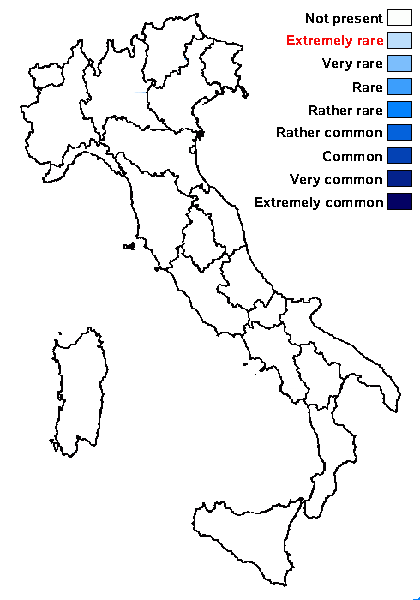Arthonia thoriana Ertz & N. Sand.
in Ertz & al., Lichenologist, 50: 163, 2018.
Synonyms:
Distribution:
Description: Thallus crustose, episubstratic, up to 60 µm thick, white, continuous to cracked, most probably not lichenized, but frequently associated with colonies of free-living green algae. Apothecia arthonioid, solitary and scattered, rarely contiguous, sessile, rounded, emarginate, 0.12-0.3 mm across, flat to convex, pale brown, at least partially covered in a thin layer of white pruina. Proper exciple poorly developed; epithecium brown up to 5 µm high, K+ greyish, covered in crystals of calcium oxalates; hymenium colourless to very pale brown, 35-45 µm high, the hymenial gel I+ dark red with small parts I+ persistently dark blue, K/I+ blue; paraphysoids abundant, richly anastomosing, c. 1 µm thick, the apical cells not or only slightly enlarged, up to 2 µm wide; hypothecium colourless to pale brown, 10-22 µm high. Asci (6-)8-spored, pear-shaped, shortly stipitate, (22-)23-30(-35) x 10-13 µm, the wall more or less thickened at apex, 3-6 µm thick, I-, K/I- but with a thin I+ orange layer on its surface, with or without a distinct ocular chamber, without K/I blue ring structures in tholus. Ascospores (1-)3-septate, persistently hyaline, clavate, the terminal cells smaller than the others, 8-12 x 3-4 µm, without a gelatinous sheath. Photobiont probably absent. Spot tests: thallus K-, C-, KC-, P-, UV-. Chemistry: an unidentified terpenoid.Note: a most probably non-lichenized species described from the British Isles and later found in the Crech Republic and Austria, growing on the dry sides of trunks of old deciduous trees, mainly oaks in udisturbed old forests. To be looked for in Italy.
Growth form: Fungus
Substrata: bark
Reproductive strategy: mainly sexual
In underhangs rarely wetted by rain

Predictive model
Growth form: Fungus
Substrata: bark
Reproductive strategy: mainly sexual
In underhangs rarely wetted by rain

Predictive model

